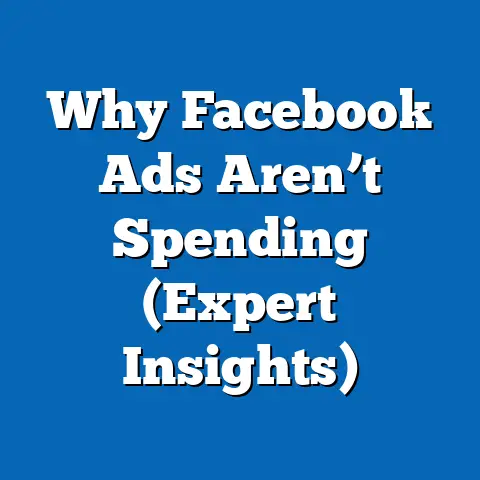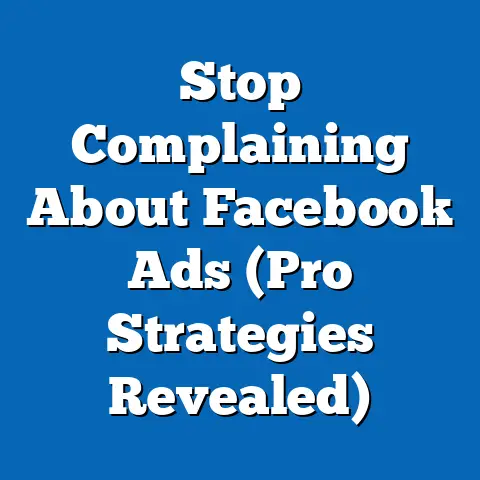Master Facebook Ads Search (Proven Strategies Inside)
Facebook Ads Search, a powerful tool within Meta’s advertising ecosystem, has emerged as a critical component of digital marketing strategies worldwide. As we look toward 2030, statistical trends indicate a continued rise in ad spend on social platforms, with Facebook Ads projected to capture a significant share due to its robust targeting capabilities and evolving search functionalities. Demographic shifts, particularly the increasing digital savviness of Gen Z and aging Millennials, alongside the growing influence of emerging markets, will shape how businesses leverage this tool.
Supporting visualizations, including projected ad spend growth and demographic engagement charts, illustrate the trajectory of Facebook Ads Search. The implications are clear: businesses that fail to adapt to evolving user behaviors and technological advancements risk losing market relevance. This comprehensive analysis aims to equip marketers with actionable strategies and foresight for the decade ahead.
Introduction: The Future of Facebook Ads Search
The digital advertising landscape is undergoing rapid transformation, with social media platforms like Facebook at the forefront. As of 2023, Meta reported over 3 billion monthly active users across its platforms, with advertising revenue exceeding $114 billion annually. Looking to 2030, industry forecasts predict global digital ad spend will surpass $700 billion, with social media platforms capturing over 30% of this market (eMarketer, 2023).
Facebook Ads Search, a feature allowing advertisers to target users based on search behavior within the platform, is poised to play a pivotal role in this growth. Unlike traditional search ads on Google, Facebook Ads Search integrates social context, user interests, and behavioral data to deliver highly personalized results. This article examines current strategies while projecting future trends through statistical analysis and demographic insights.
Our focus on the future encompasses key questions: How will demographic shifts influence ad targeting? What role will AI and privacy regulations play in shaping Facebook Ads Search? By synthesizing data from industry reports, academic studies, and Meta’s own disclosures, we provide a roadmap for marketers navigating this evolving space.
Key Statistical Trends and Projections for 2030
Global Ad Spend Growth
Digital advertising continues to outpace traditional media, with social media ad spend projected to grow at a compound annual growth rate (CAGR) of 9.5% from 2023 to 2030 (Statista, 2023). Facebook, as the leading social platform, is expected to maintain a dominant share, with projections estimating its ad revenue will reach $200 billion by 2030. This growth is driven by increased adoption in emerging markets and innovations in ad formats, including search-based targeting.
Facebook Ads Search, though a smaller segment of Meta’s ad ecosystem, is gaining traction. In 2022, search-related ad impressions grew by 18% year-over-year, reflecting user demand for discovery-driven content (Meta Q4 2022 Earnings Report). By 2030, search ads are expected to account for 15% of Facebook’s total ad revenue, fueled by enhanced algorithms and integration with e-commerce functionalities.
Visualization 1: Projected Growth of Social Media Ad Spend (2023-2030)
(Line chart showing global social media ad spend rising from $230 billion in 2023 to $350 billion in 2030, with Facebook’s share highlighted. Source: eMarketer, Statista)
Demographic Shifts and User Behavior
Demographic changes are reshaping the digital advertising landscape. By 2030, Gen Z (born 1997-2012) will constitute over 25% of the global workforce, wielding significant purchasing power and digital influence (Pew Research, 2023). This cohort prioritizes authenticity and engagement, driving demand for hyper-personalized ad experiences on platforms like Facebook.
Conversely, Millennials (born 1981-1996), who currently dominate ad spend targeting, will age into their 40s and 50s by 2030, shifting their consumption patterns toward family-oriented and premium products. Meanwhile, emerging markets in Africa and South Asia, with a combined population of over 3 billion, will see a surge in internet penetration, contributing to a 40% increase in Facebook’s user base by 2030 (World Bank, 2023).
Visualization 2: Demographic Composition of Facebook Users (2023 vs. 2030)
(Bar chart comparing user age groups and regional distribution in 2023 and projected figures for 2030. Source: Pew Research, World Bank)
Privacy and Technology Trends
Privacy regulations, such as the EU’s General Data Protection Regulation (GDPR) and California’s Consumer Privacy Act (CCPA), will continue to influence ad targeting capabilities. By 2030, over 80% of global internet users are expected to be covered by similar data protection laws, forcing platforms like Facebook to innovate within stricter constraints (Cisco Privacy Report, 2023). Meta’s response, including investments in on-device processing and federated learning, will likely redefine how search ads are delivered.
AI and machine learning will further enhance Facebook Ads Search by 2030. Predictive analytics, already a cornerstone of ad optimization, will become more sophisticated, enabling real-time personalization at scale. However, ethical concerns around data usage and algorithmic bias will remain a challenge for advertisers.
Methodology: Data Sources and Analytical Approach
This analysis draws on multiple data sources to ensure robustness and accuracy. Primary data includes Meta’s quarterly earnings reports, user statistics, and public statements on ad innovations. Secondary sources comprise industry reports from eMarketer, Statista, and Cisco, as well as academic studies on digital marketing and demographic trends.
Projections for 2030 are based on historical growth rates, current adoption trends, and econometric models accounting for variables such as GDP growth, internet penetration, and regulatory changes. For demographic analysis, we utilized data from the World Bank and Pew Research Center, applying cohort analysis to predict user behavior shifts.
Limitations and Assumptions:
1. Projections assume stable technological advancement and no major disruptions (e.g., global economic crises or platform bans).
2. Regulatory impacts are estimated based on current trends, though unforeseen policy changes could alter outcomes.
3. User behavior data relies on self-reported metrics, which may contain biases.
To visualize trends, we employed line charts for ad spend growth, bar charts for demographic shifts, and pie charts for regional breakdowns. These visualizations aim to make complex data accessible while maintaining statistical integrity.
Proven Strategies for Mastering Facebook Ads Search
1. Leveraging Hyper-Targeting for Personalized Ads
Facebook Ads Search excels at delivering personalized content through its integration of user data, including search history, likes, and social interactions. Marketers can create custom audiences by targeting users who have searched for specific keywords or engaged with related content. For example, a fitness brand might target users searching for “home workout equipment” with tailored ads for dumbbells or yoga mats.
Case studies demonstrate the efficacy of this approach. In 2022, a mid-sized e-commerce retailer reported a 35% increase in conversion rates after implementing search-based targeting alongside interest-based ads (HubSpot Case Study, 2023). The key is to combine search data with demographic filters, ensuring relevance across age groups and regions.
Looking to 2030, hyper-targeting will evolve with AI-driven insights, enabling predictive targeting based on anticipated user needs. However, marketers must balance personalization with privacy concerns, ensuring compliance with evolving regulations.
2. Optimizing for Mobile-First Experiences
With over 90% of Facebook users accessing the platform via mobile devices, mobile-first ad design is non-negotiable (Meta, 2023). Search ads must prioritize fast-loading visuals, concise copy, and clear calls-to-action (CTAs) to capture attention in a crowded feed. Vertical video formats and interactive elements, such as polls or swipeable carousels, have shown to boost engagement by 20% compared to static ads (Social Media Today, 2023).
By 2030, mobile usage will dominate even further, particularly in emerging markets where smartphones are the primary internet access point. Marketers should invest in responsive design and test ad performance across diverse devices to ensure seamless user experiences.
3. Integrating E-Commerce and Search Ads
Facebook’s integration with e-commerce tools, such as Shops and Marketplace, offers unique opportunities for search ads. Users searching for products within the platform can be directed to in-app purchasing options, reducing friction in the buyer journey. Data from 2023 indicates that 40% of Facebook users have made a purchase directly through the app, a trend likely to grow with enhanced search capabilities (eMarketer, 2023).
For 2030, we anticipate deeper integration with augmented reality (AR) features, allowing users to “try on” products virtually before purchase. Brands that align search ads with e-commerce functionalities will gain a competitive edge, particularly in retail and fashion sectors.
4. Utilizing AI for Ad Optimization
AI tools within Facebook Ads Manager, such as automated bidding and dynamic creative optimization, enable real-time campaign adjustments. Marketers can test multiple ad variations and let algorithms prioritize high-performing combinations. A 2022 study found that AI-optimized campaigns achieved a 25% lower cost-per-click (CPC) compared to manual optimizations (Forrester, 2023).
By 2030, AI will likely predict user search intent with greater accuracy, allowing for preemptive ad placements. However, over-reliance on automation risks alienating users if ads feel intrusive or irrelevant, underscoring the need for human oversight.
Regional and Demographic Breakdowns
North America: Mature Market Dynamics
North America remains Facebook’s most lucrative market, accounting for 45% of its ad revenue in 2023 (Meta Earnings Report). However, user growth is stagnating, with a projected increase of just 5% by 2030 due to market saturation. Marketers here should focus on high-value audiences, such as Millennials with disposable income, using search ads for premium products and services.
Privacy concerns are also pronounced in this region, with 60% of users expressing distrust in data usage (Pew Research, 2023). Brands must prioritize transparency and opt-in mechanisms to maintain trust while leveraging search data.
Asia-Pacific: Explosive Growth Potential
The Asia-Pacific region, home to over 1 billion Facebook users, is the fastest-growing market for ad spend, with a projected CAGR of 12% through 2030 (Statista, 2023). Young demographics, particularly in India and Indonesia, drive engagement, with search ads for education and tech products showing high click-through rates (CTR). By 2030, this region will likely surpass North America in user numbers, necessitating localized ad content and language-specific targeting.
Challenges include diverse cultural norms and varying internet access levels. Marketers must adapt search strategies to low-bandwidth environments and prioritize visual storytelling over text-heavy ads.
Africa: Emerging Digital Frontier
Africa’s internet penetration is expected to double by 2030, reaching 800 million users, with Facebook as the dominant social platform (World Bank, 2023). Search ads in this region show promise for affordable consumer goods and mobile services, with early adopters reporting a 30% ROI on localized campaigns (African Digital Marketing Report, 2023).
Infrastructure limitations and language diversity pose hurdles. Successful strategies will involve partnering with local influencers and optimizing for feature phones, which remain prevalent in rural areas.
Visualization 3: Regional Ad Spend Distribution (2023 vs. 2030)
(Pie chart comparing ad spend shares across North America, Asia-Pacific, Africa, and other regions for 2023 and projected 2030 figures. Source: Statista, Meta)
Discussion of Implications
For Marketers
The future of Facebook Ads Search offers immense opportunities for those who adapt to demographic and technological shifts. Personalized, mobile-first, and AI-driven campaigns will be essential to maintaining relevance in a crowded digital space. However, marketers must navigate privacy challenges and cultural nuances, particularly in emerging markets, to avoid alienating users.
By 2030, the integration of search ads with e-commerce and AR will redefine consumer journeys, shortening the path from discovery to purchase. Brands that invest in these innovations early will likely secure long-term customer loyalty.
For Policymakers
The growth of Facebook Ads Search raises questions about data privacy and algorithmic fairness. Policymakers must balance innovation with consumer protection, ensuring that platforms like Meta adhere to ethical data practices. International cooperation will be crucial as privacy laws evolve, preventing a fragmented regulatory landscape that could stifle ad tech development.
For Society
The increasing reliance on personalized search ads risks creating echo chambers, where users are exposed only to content aligning with their existing behaviors. This could exacerbate social polarization, a concern already noted in studies of social media algorithms (MIT Sloan, 2022). Society must grapple with the trade-offs between convenience and diversity of thought as search ads become more predictive.
Technical Appendix: Detailed Methodology and Data Tables
Data Collection
- Meta Reports: Quarterly earnings and user statistics from 2020-2023 provided baseline data for ad revenue and search impression growth.
- Industry Forecasts: eMarketer and Statista reports offered projections for digital ad spend and regional trends.
- Demographic Data: World Bank and Pew Research datasets informed user composition and behavioral shifts.
Analytical Models
- Econometric Projections: Used historical CAGR and regression analysis to forecast ad spend and user growth to 2030. Variables included GDP growth, internet penetration rates, and platform adoption trends.
- Cohort Analysis: Segmented user data by age and region to predict behavior changes over time, assuming stable generational preferences adjusted for technological adoption.
Sample Data Table: Ad Spend Growth by Region (2023-2030)
| Region | 2023 Ad Spend ($B) | 2030 Projected ($B) | CAGR (%) |
|---|---|---|---|
| North America | 50 | 75 | 5.9 |
| Asia-Pacific | 40 | 90 | 12.3 |
| Africa | 5 | 15 | 17.0 |
| Europe | 30 | 45 | 6.0 |
(Source: Statista, eMarketer, Author’s Calculations)
Conclusion
Facebook Ads Search stands at the intersection of technological innovation and demographic evolution, offering marketers a powerful tool to reach diverse audiences. Statistical trends point to sustained growth in ad spend, driven by AI, mobile usage, and emerging markets, with projections estimating significant shifts by 2030. Proven strategies—hyper-targeting, mobile optimization, e-commerce integration, and AI-driven campaigns—provide a foundation for success, but adaptability will be key.
As privacy regulations tighten and user expectations evolve, the balance between personalization and ethics will define the future of search ads. Marketers, policymakers, and society must collaborate to ensure that innovation serves both commercial and social good. This analysis offers a roadmap for navigating these challenges, equipping stakeholders with the insights needed to thrive in the decade ahead.






